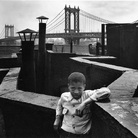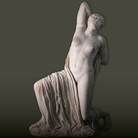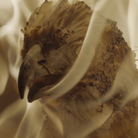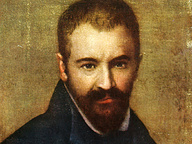Fausta Squatriti. Memento mori

Fausta Squatriti. Memento mori, Galleria Weber & Weber, Torino
Dal 5 November 2014 al 17 January 2015
Torino
Luogo: Galleria Weber & Weber
Indirizzo: via S. Tommaso 7
Orari: da martedì a sabato 15.30-19.30
Costo del biglietto: ingresso gratuito
Telefono per informazioni: +39 011 19500694
E-Mail info: direzione@galleriaweber.it
Sito ufficiale: http://www.galleriaweber.it
La Galleria Weber & Weber presenta il lavoro recente di Fausta Squatriti, figura nota per l’ampiezza del suo campo espressivo condotto fin dagli esordi, nei primi anni ’60, con una personale ricerca trasversale che l’impegna sia nelle arti visive che nella scrittura, della quale si sono interessati grandi maestri come Gillo Dorfles e Giulio Carlo Argan, e critici delle più giovani generazioni.
Questa volta è lo storico dell’arte Dieter Ronte a scrivere di questa mostra “Memento mori”, nella quale sono esposte le opere degli ultimi quattro anni, espresse in tre diversi cicli tematici. Riccarda Turrina attraverso una lunga intervista con l’artista, indaga circa ragioni e modi che conducono Squatriti, da oltre cinquant’anni, in una ricerca totale, che pur tenendo conto di quanto accade nel mondo dell’arte in questi decenni, se ne discosta, quando non lo anticipa.
Alla fine degli anni ’80 l’artista da una svolta importante alla sua ricerca, basata sul rigore formale geometrico, e inizia una sorprendente evoluzione, sia tematica che formale. Si avvale ora di una complessa struttura compositiva, dittici, trittici, installazioni, che uniscono superficie e volume, attraverso l’uso di fotografia, segni astratti, e oggetti tridimensionali, uniti dalla necessità di porre il dito nella piaga, la contraddizione, ma anche l’equilibrio, che regola la vita nel creato, espresso nel senso del tragico, come destino ultimo dell’esistente.
La sua originaria passione per la struttura, alla base delle sculture degli anni ’80, con mutati valori formali, la conduce ai non scontati esiti di una algida messa in scena che rifugge dai pericoli del racconto e del giudizio morale. Squatriti osserva, denuda, con lucidità pervasa di pietas, senza l’eccesso narrativo del dramma.
Altro tratto che collega la ricerca attuale di Squatriti a quella inconsapevole dei suoi inizi adolescenziali, è il ritorno al disegno, antica passione e maestria, abbandonata negli anni del rigore. Già da anni l’artista ha ripreso in mano la matita, disegnando sorprendenti fiori indagati nei loro minimi dettagli anatomici, facendone una sorta di autopsia.
Ma ora ha alzato la posta con due cosmogonie di grandi dimensioni, cui ha dato il titolo di Memento Mori. Il fitto di fiori, freschi, appassiti, marci, secchi, ingarbugliati gli uni negli altri, disegnati con la sola matita in modo magistrale, ci dice della bellezza, viatico necessario che introduce l’artista stessa e chi guarda nel cuore di una allegoria della morte: fragilità, corruzione, disfacimento di tutto quello che, per un tratto temporale, è vivo e mutevole, destinato a lasciare, anche quando umile come uno scarto, l’impronta della propria esistenza.
Su questo tema si innesta anche il complesso quanto commovente libro d’artista In memoria, creato usufruendo di documenti emersi recentemente, riguardanti l’incarcerazione a “Le Nuove” di Torino, di 36 donne ebree torinesi, molte delle quali anzianissime, avvenuta nel ’43.
Questa volta è lo storico dell’arte Dieter Ronte a scrivere di questa mostra “Memento mori”, nella quale sono esposte le opere degli ultimi quattro anni, espresse in tre diversi cicli tematici. Riccarda Turrina attraverso una lunga intervista con l’artista, indaga circa ragioni e modi che conducono Squatriti, da oltre cinquant’anni, in una ricerca totale, che pur tenendo conto di quanto accade nel mondo dell’arte in questi decenni, se ne discosta, quando non lo anticipa.
Alla fine degli anni ’80 l’artista da una svolta importante alla sua ricerca, basata sul rigore formale geometrico, e inizia una sorprendente evoluzione, sia tematica che formale. Si avvale ora di una complessa struttura compositiva, dittici, trittici, installazioni, che uniscono superficie e volume, attraverso l’uso di fotografia, segni astratti, e oggetti tridimensionali, uniti dalla necessità di porre il dito nella piaga, la contraddizione, ma anche l’equilibrio, che regola la vita nel creato, espresso nel senso del tragico, come destino ultimo dell’esistente.
La sua originaria passione per la struttura, alla base delle sculture degli anni ’80, con mutati valori formali, la conduce ai non scontati esiti di una algida messa in scena che rifugge dai pericoli del racconto e del giudizio morale. Squatriti osserva, denuda, con lucidità pervasa di pietas, senza l’eccesso narrativo del dramma.
Altro tratto che collega la ricerca attuale di Squatriti a quella inconsapevole dei suoi inizi adolescenziali, è il ritorno al disegno, antica passione e maestria, abbandonata negli anni del rigore. Già da anni l’artista ha ripreso in mano la matita, disegnando sorprendenti fiori indagati nei loro minimi dettagli anatomici, facendone una sorta di autopsia.
Ma ora ha alzato la posta con due cosmogonie di grandi dimensioni, cui ha dato il titolo di Memento Mori. Il fitto di fiori, freschi, appassiti, marci, secchi, ingarbugliati gli uni negli altri, disegnati con la sola matita in modo magistrale, ci dice della bellezza, viatico necessario che introduce l’artista stessa e chi guarda nel cuore di una allegoria della morte: fragilità, corruzione, disfacimento di tutto quello che, per un tratto temporale, è vivo e mutevole, destinato a lasciare, anche quando umile come uno scarto, l’impronta della propria esistenza.
Su questo tema si innesta anche il complesso quanto commovente libro d’artista In memoria, creato usufruendo di documenti emersi recentemente, riguardanti l’incarcerazione a “Le Nuove” di Torino, di 36 donne ebree torinesi, molte delle quali anzianissime, avvenuta nel ’43.
SCARICA IL COMUNICATO IN PDF
COMMENTI

-
 Dal 2 December 2025 al 19 February 2026
Milano | Centro Culturale di Milano
Dal 2 December 2025 al 19 February 2026
Milano | Centro Culturale di Milano
Walter Rosenblum. Il mondo e la tenerezza
-
 Dal 30 November 2025 al 12 April 2026
Gallarate | Museo MA*GA
Dal 30 November 2025 al 12 April 2026
Gallarate | Museo MA*GA
Kandinsky e l’Italia
-
 Dal 29 November 2025 al 12 April 2026
Roma | Musei Capitolini
Dal 29 November 2025 al 12 April 2026
Roma | Musei Capitolini
La Grecia a Roma
-
 Dal 22 November 2025 al 3 May 2026
Torino | Sale Chiablese dei Musei Reali
Dal 22 November 2025 al 3 May 2026
Torino | Sale Chiablese dei Musei Reali
Orazio Gentileschi. Un pittore in viaggio
-
 Dal 20 November 2025 al 25 January 2026
Firenze | Palazzo Strozzi
Dal 20 November 2025 al 25 January 2026
Firenze | Palazzo Strozzi
Andro Eradze. Bones of Tomorrow
-
 Dal 21 November 2025 al 28 March 2026
Cuneo | Complesso Monumentale di San Francesco
Dal 21 November 2025 al 28 March 2026
Cuneo | Complesso Monumentale di San Francesco
La Galleria Borghese. Da Raffaello a Bernini. Storia di una collezione


